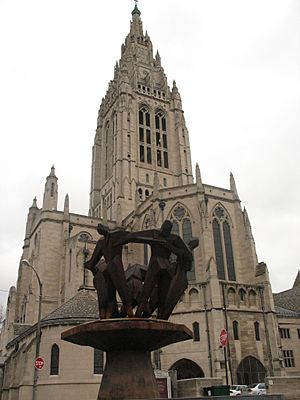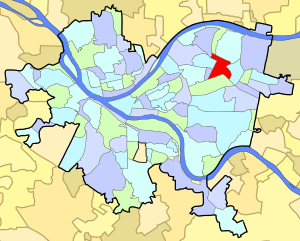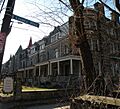East Liberty (Pittsburgh) facts for kids
Quick facts for kids
East Liberty
|
|
|---|---|
|
Neighborhood of Pittsburgh
|
|

East Liberty Presbyterian Church
|
|
 |
|
| Country | United States |
| State | Pennsylvania |
| County | Allegheny County |
| City | Pittsburgh |
| Area | |
| • Total | 0.581 sq mi (1.50 km2) |
| Population
(2010)
|
|
| • Total | 5,869 |
| • Density | 10,102/sq mi (3,900/km2) |
|
East Liberty Commercial Historic District
|
|
| Lua error in Module:Location_map at line 420: attempt to index field 'wikibase' (a nil value). | |
| Area | Roughly bounded by Penn, Sheridan, and Centre Avenues and Kirkwood and South Whitfield Streets |
|---|---|
| NRHP reference No. | 10001072 |
| Added to NRHP | December 27, 2010 |
East Liberty is a lively neighborhood in Pittsburgh, Pennsylvania. It's located in the city's East End. You can find it next to areas like Highland Park and Shadyside. A famous building in its skyline is the beautiful East Liberty Presbyterian Church.
Contents
How East Liberty Began
Around the time of the American Revolution, East Liberty was a wide-open space. It was used for animals to graze freely. This area was a few miles east of the growing town of Pittsburgh. In old English, a "liberty" meant a common piece of land outside a town.
Two important farming families owned most of the land nearby. Their family names are still used for streets in East Liberty today. John Conrad Winebiddle owned land to the west. His daughter, Barbara, inherited some of it near East Liberty. Alexander Negley owned a farm called "Fertile Bottom" to the north. His land included parts of East Liberty and other nearby areas.
Alexander Negley's son, Jacob, married Barbara Winebiddle. They built a large house and created a village. Jacob named it East Liberty, after the old grazing lands. In 1816, Jacob made sure a major road, the Pittsburgh-Greensburg turnpike, went through East Liberty. This helped the area become a busy trading spot and grow even more.
Growing into a Busy Place
East Liberty really started to become a commercial center in 1843. This happened when Jacob Negley's daughter, Sarah Jane, married a smart lawyer named Thomas Mellon. Mellon had seen the Negley mansion when he was ten years old and wanted something similar. He became a successful lawyer. Then he made a lot of money by selling or renting the land Sarah Jane inherited. He used this money to help start new industries in Pittsburgh.
Like Jacob Negley, Thomas Mellon also worked to make East Liberty a transportation hub. He helped bring some of Pittsburgh's first trolley lines through the neighborhood. This made it easier for people to travel to and from East Liberty.
East Liberty grew quite a bit on its own. But it really connected with Pittsburgh when the Pennsylvania Railroad opened the East Liberty station in the 1850s. This train station linked East Liberty to the city. About 26 trains traveled to and from downtown every day. This rail connection was very important for the area's future. Pittsburgh was about to enter a huge industrial boom. This period lasted from the end of the Civil War until World War I.
As Pittsburgh's population grew for the iron and steel industries, East Liberty grew too. The neighborhood's population went from under 1,000 in 1850 to over 46,000 by 1910. At first, East Liberty was a place where wealthy families lived. They wanted to escape the smoke and dirt of the industrial city. By the early 1900s, it was one of the richest suburbs in America. Many rich business owners had their mansions there.
However, East Liberty was not just for the wealthy. The train station brought many European immigrants and African American people from the South. They came for Pittsburgh's factory jobs. By the late 1800s, the neighborhood had many churches for different religions and cultures. There were places of worship for German and Italian Protestants, Irish, Italian, and German Catholics. There was also a Presbyterian church for Anglo-Americans and an AME church for African Americans. East Liberty's diverse mix of people stayed strong until after World War II.
In 1868, the City of Pittsburgh officially took over East Liberty. Because of its good location and Mellon's help, East Liberty became a busy shopping area. Merchants in East Liberty served many of Pittsburgh's rich families. These families lived in nearby Shadyside and Point Breeze. People from Highland Park, Friendship, Bloomfield, and Garfield also shopped in East Liberty. There were four movie theaters. Famous actor and singer Dick Powell started his career singing at the Enright Theater. By 1950, East Liberty was a bustling marketplace. It had large stores like Sears-Roebuck and Mansmann's Department Store. It became the biggest business district outside of a city center in the country.
Challenges and Changes
East Liberty faced challenges starting in the 1930s. A government policy made it hard for people to get loans for homes in certain areas. This policy was called "redlining." It meant banks saw some neighborhoods as risky for loans. Many homes in East Liberty were older wooden houses. Surveys in 1937 called this housing "obsolete." They also noted that many people were receiving government help. This led to East Liberty being "redlined."
Because of redlining, it was hard to get loans to buy or fix homes. This caused property values to drop. Without money for repairs, homes got worse over time. When urban renewal projects happened in the 1960s, the areas that were redlined in 1937 were often torn down.
Even the nicer neighborhoods north of the redlined areas were affected. These areas had larger brick homes and wealthy estates. But surveys still called them "mediocre" and "higher risk" for lenders. While these areas also declined, they were not destroyed as much by urban renewal.
Two big decisions in the 1960s made things even harder for East Liberty. Businesses started moving from the city to the suburbs. Some of East Liberty's larger stores worried about this. They asked the City of Pittsburgh's Urban Redevelopment Authority (URA) for help.
The URA decided to create an outdoor walking mall on Penn Avenue. It would be surrounded by new roads for cars. This plan meant tearing down about half of East Liberty. The areas chosen for demolition were mostly those that had been redlined. After much discussion, the plan was approved. The URA stopped traffic on the busiest part of Penn Avenue. They rerouted it onto new one-way roads called Penn Circle. These roads formed a ring around the main business area.
Many small shops were destroyed, about a million square feet of retail space. This ruined the dense, walkable shopping district. It was replaced with parking lots and empty spaces. This made businesses that stayed decline even faster.
At the same time, Pittsburgh's housing authority made changes. They noticed that the nearby African-American neighborhood of Homewood was very crowded. This was partly because the URA had torn down parts of the Hill District to build the Civic Arena. This forced many African-Americans to move to the North Side and Homewood. The housing authority decided to build three large apartment buildings, almost 20 stories tall, in East Liberty. They were built along the new Penn Circle roads.
These two plans did not help East Liberty. In fact, they made things worse. By sending cars away from Penn Avenue, the new street plan made it seem like the shopping area wasn't worth visiting. The large apartment buildings quickly gained a reputation for problems. This also drove businesses away. Redlining had already pushed away middle-class homebuyers. The new public housing was only for low-income renters. This created a population that was very poor and couldn't support a healthy shopping area.
Urban renewal had very bad effects on the neighborhood. In 1959, East Liberty had about 575 businesses. By 1970, there were only 292. By 1979, there were just 98. The businesses that remained mostly served the people who were left in what had become a struggling area.
The population also dropped a lot after urban renewal. East Liberty became a neighborhood with high poverty and low homeownership. This lack of investment continued for many years. From 1990 to 2016, the population fell from 7,973 to 5,698. This was due to the lasting effects of urban renewal and redlining. A study in 2018 showed that many homes were abandoned because they were in poor condition. You can still see evidence of this in empty lots and new buildings on former vacant land.
A New Beginning and Growth
In the years after 1980, East Liberty slowly started to become a popular shopping spot again.
In 1979, local banks and businesses created a non-profit group called East Liberty Development, Inc. (ELDI). They worked to improve the area. In the 1980s, ELDI led many important projects. They bought and fixed up an empty hotel. They also bought a block with the Regent Theater and Penn Highland Building. ELDI worked with developers to bring new apartments and a shopping center called East Liberty Station to Penn Avenue. During the 1980s, the number of small shops grew. More than 200 businesses opened in East Liberty. Over $80 million was invested in new buildings. For the first 15 years, ELDI focused on fixing up East Liberty's old commercial buildings. These included the Regent Theater, now called the Kelly-Strayhorn Theater, and Motor Square Garden.
ELDI's projects took a lot of time. They didn't immediately make the neighborhood a big shopping destination. For example, ELDI and the Massaro Corporation turned the Motor Square Garden building into an indoor mall in 1988. But shoppers didn't come. The American Automobile Association bought the building in 1991 and now uses it for offices.
Besides fixing up buildings, ELDI also removed the failed walking mall on Penn Avenue. They changed the street back to its original use as a two-way street. These successes prepared the way for bigger changes in the late 1990s and 2000s.
Between 1996 and 2006, ELDI and the City of Pittsburgh worked to attract large stores to East Liberty. They also worked to remove the tall apartment buildings that surrounded the neighborhood. First, ELDI and the City used special funding to bring two national stores: Home Depot and Whole Foods. Both stores did very well. Their success convinced smaller local shops and other national stores to invest in the neighborhood. Second, after a lot of planning, two of the three tall apartment buildings were torn down in 2005. The third was demolished in May 2009.
These efforts involved moving the mostly African-American residents from the apartment buildings. They also brought in several high-end stores. Because of this, some people criticized ELDI and the City for causing Gentrification. This means that an area becomes more expensive and changes its character. However, new mixed-income housing has been built where the old buildings stood. These new homes offer nicer and safer places for some former residents, though fewer people can live there now.
By 2009, East Liberty looked more like the busy shopping neighborhood of 1959 than the struggling area of 1979. Businesses continue to invest in the neighborhood. Many people now see it as fully recovered.
In 2010, The New York Times wrote an article about East Liberty's comeback. They mentioned that a Google office had opened there as a sign of its success.
In 2011, the Pittsburgh Post-Gazette wrote about "The Beauty Shoppe." This was East Liberty's first Coworking space. It's owned by East Liberty Development Inc. and houses several new businesses.
The Highland Building, a tall building that was empty for 20 years, has been turned into fancy apartments. The Wallace Building next to it also became apartments.
In April 2014, the streets that made up Penn Circle were renamed. This removed a clear reminder of the failed urban renewal plans from the 1960s. Some historic street names were brought back. Centre Avenue was also extended. This made it easier for visitors to find their way to the business district.
In June 2014, USA Today named East Liberty one of the ten best up-and-coming neighborhoods in the USA.
Getting Around East Liberty
East Liberty has its own train station, called the East Liberty Transit Center. This station is on the Martin Luther King Jr. East Busway. The station was updated in 2015. This public project aimed to build homes and shops close to public transportation. The goal was to encourage more people to live in the city and use fewer cars. The transit center makes it easier to access the East Busway. This busway runs along the path where the Pennsylvania Railroad used to be. It connects Downtown Pittsburgh with East End neighborhoods and eastern suburbs. This project cost $150 million and added 3,000 square feet of mixed-use commercial space.
This project has caused a lot of discussion about the lack of affordable housing in East Liberty. The project's tax program was meant to encourage development. But it has resulted in public money going to private developers for expensive apartments.
Culture and Famous People
In 2009, the Remnant Choir from East Liberty's Mt. Ararat Baptist Church won second place in a national contest. They won $20,000 in prize money. The contest was sponsored by Verizon Wireless and looked for the "Best Church Choir in America."
Legendary actor and dancer Gene Kelly was born in East Liberty in 1912.
David Tepper, a businessman who owns the NFL's Carolina Panthers and the MLS's Charlotte FC, used to live in East Liberty.
Gallery
-
Alpha Terrace Historic District, built around 1885.
-
East Liberty Market (also known as Motor Square Garden), built from 1898 to 1900.
-
Whitehill-Gleason Motors (built around the 1920s), on the site of the first Drive-In Filling Station (1913).
-
A Target retail store next to smaller shops and eateries on Centre Ave.










